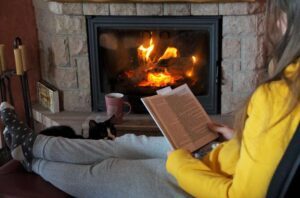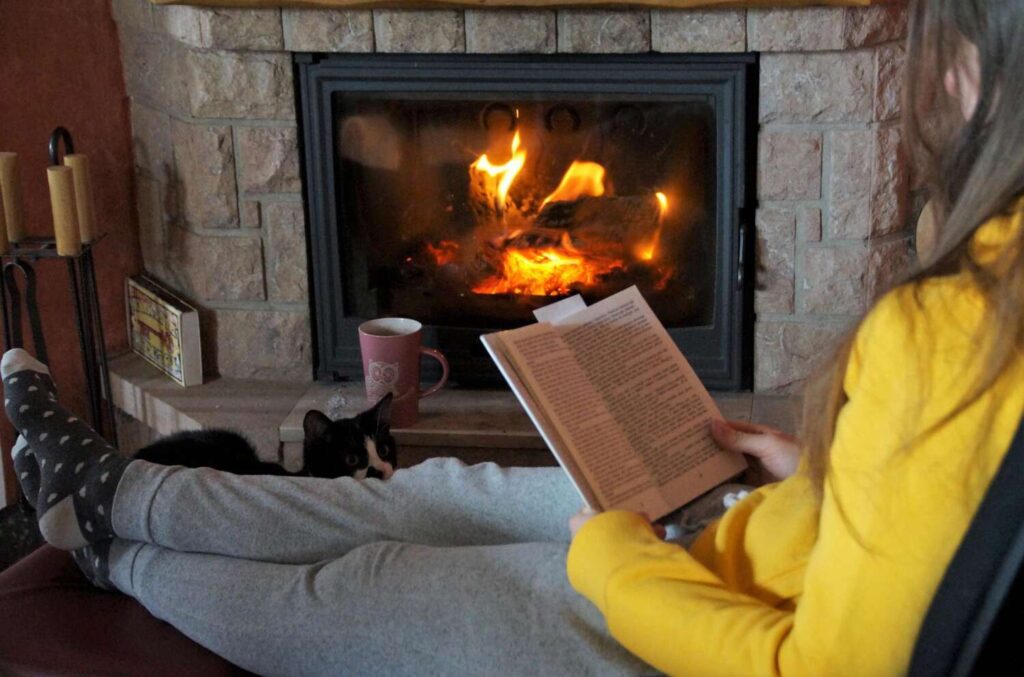Ah, fireplaces. Few design decisions are more technical or more emotional than that of how to operate a fire safely and effectively inside a building.
Fire is a deeply rooted part of the human psyche. It is also a chemical reaction whose byproducts are harmful to human health, and that requires a specific environment to occur successfully.
These are fundamental laws of nature (and human nature) that often butt heads in today’s buildings.
Local energy raters like to joke that February is “fireplace month” in their offices, because it’s the time of year when the phone starts ringing off the hook with people whose fireplaces aren’t working right in their new home.
Are Fireplaces Incompatible with Green Building?
No, but you must get the right kind, and respect building physics.
When fireplaces don’t work well, there are two common issues. First, the combustion byproducts end up in the indoor air, potentially harming property and human bodies, or second, the fire won’t light, won’t stay lit, or won’t sustain a satisfactory kind of flame.
Modern homes can exacerbate the problem compared to older homes, where open fireplaces were once common. Our buildings are much more air-tight now — a win for heating and cooling costs and many aspects of indoor air quality, but as a result, changes in building pressure from exhaust fans, open windows, or even a particularly windy day can more easily wreak havoc on effective chimney operation. This can fill the indoor air with smoke and particulates, and cause fires to struggle to stay lit.
However, it’s worth stressing that open fires in older homes have long been recognized as a health risk; the “good old days” weren’t always good. Before we go blaming modern buildings for being too air-tight, we must remember that our comfort standards have also changed.
Even back when open fireplaces were the only source of heat in buildings, they didn’t actually work very well; it’s just that people didn’t have better options. You might have felt a little bit warmer standing right next to one, but the net effect of pushing so much warm air out of the chimney was actually to suck cold air in through cracks in the building’s leaky exterior, making exterior rooms colder. (Those physics are still true today.)
Our standards for indoor air quality (and our growing knowledge of the health impacts) are also much advanced from the days of fireplace yore.
What Types of Fireplaces Are Acceptable?
There are still two types of fireplaces that work just fine and are fully approved by green building programs.
Direct-vent gas (or propane): Direct-vent fireplaces have sealed glass doors, isolating the flame from indoor air. These fireplaces have outside air intakes that pull the needed oxygen to operate from outside of the home, not from your living room, and they exhaust their combustion fumes to the outside as well.
They do all of this in a manner totally sealed off from your indoor air. This not only protects you from a direct physical path for combustion fumes to reach you, it also protects the fireplace chamber from air pressure differences that otherwise pull exhaust into the living space.
There are a lot of things in a home that can create such suction: a bath fan, your dryer vent, or perhaps that stylish super high CFM (cubic feet per minute) range hood. Direct-vent fireplaces, because they are sealed, don’t feel suction created when one of those fans is operating. They can keep doing their thing, and you can keep doing yours.
EPA-qualified, sealed combustion wood fireplace (or freestanding wood stove): The same physics applies to burning wood (or even pellets), although the wood industry doesn’t tend to use the term “direct vent.” But you can get a wood stove or wood stove insert with an outside air intake that connects directly into the firebox, and one that has a tightly latching door mechanism, effectively creating the same situation.
These fireplaces come in all kinds of styles to match varying appearance needs. The same specs should be used whether it is a fireplace built into a mantle as pictured, or a freestanding wood stove or pellet stove.
If the fireplace or stove is EPA qualified for low particulate matter, includes an outside air intake kit, and is HUD approved for mobile home use, it’s good to go. (Because mobile homes are so small, only the tightest and safest appliances can be used in them.) As an added bonus, these units burn cleaner and your neighbors will thank you for the better outdoor air.
What About Other Types?
There are many other types of fireplaces still being put into new homes every day and they are all varying degrees of sub-optimal.
They include: “vent-free” fireplaces, open wood fireplaces

not so different from the ones of yore, open fireplaces that have a big fan in the chimney to try to suck the exhaust out, gas log inserts for an old wood fireplace, and fireplaces or wood stoves that are relatively sealed but lack the outside air intake. Many of these are disallowed or complicate the process of participating in a green-building certification program.
We do recognize that people have aesthetic reasons for making decisions. We recognize that the fireplaces we are labeling as problematic exist in different home contexts where they may have seemed to work fine. We recognize the strong emotional connection humans have to fire, and that any individual’s risk calculus when it comes to low level air pollutant exposure is a personal decision (albeit one that most people make with incomplete information).
But we can also tell you that when homeowners buy a home with a fireplace, they expect it to work, and we’ve seen far too many unhappy homeowners when it doesn’t. Amy has seen $30,000 worth of smoke damages come out of a poor fireplace choice. Leigha has watched a builder pay big appeasement bucks to add an outside air intake to a wood stove that just wouldn’t light.
What Do Green Building Programs Say?
Green Built Alliance’s Green Built Homes certification system requires that fireplaces have outside air intakes, and tightly fitting doors if they are gas, and the program requires a carbon monoxide alarm in each room with a fireplace.
ENERGY STAR® for Homes does technically allow vented fireplaces that don’t otherwise meet the definition of direct vent, but it also places limits on the size of the home’s exhaust fans. This can be very limiting and costly if you have to add fan-driven kitchen makeup air. Even then, it’s often not a sufficient condition to make the fireplace actually draw well. This is particularly true if a home is located on a mountainside where it experiences high wind conditions.
A last piece of advice: don’t do a see-through fireplace in an exterior wall (so you can see from inside to outside). In addition to being incredibly gimmicky, they’re impossible to air seal around and we worry about condensation. If you want indoor and outdoor fireplaces, just do back-to-back fireplaces with an insulated wall between them.
Amy Musser, Ph.D., of Vandemusser Design is a mechanical engineer and energy rater who has inspected hundreds of certified green homes. She is an ASHRAE fellow and noted national expert on indoor air quality, and loves her EPA-qualified fireplace, though she admits her home is so efficient she doesn’t use it much. Connect with Amy at vandemusser.com.
Leigha Dickens, green building program manager with Green Built Alliance, applies a background in physics to helping make buildings in our region healthier and energy efficient. She manages our Green Built Homes Program. Connect with Leigha at Leigha@greenbuilt.org.
You can also view this article as it was originally published on page 56 of the 2022-23 edition of the directory.


